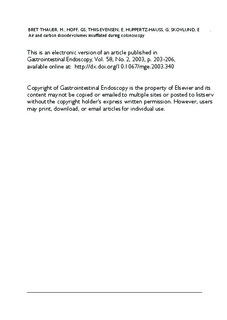Air and carbon dioxide volumes insufflated during colonoscopy
Journal article, Peer reviewed
Permanent lenke
http://hdl.handle.net/11250/2439240Utgivelsesdato
2003Metadata
Vis full innførselSamlinger
- Gastroenterologi [7]
Originalversjon
Bretthauer, M., Hoff, G. S., Thiis-Evensen, E., Huppertz-Hauss, G., & Skovlund, E. (2003). Air and carbon dioxide volumes insufflated during colonoscopy. Gastrointestinal Endoscopy, 58(2), 203-206. http://dx.doi.org/10.1067/mge.2003.340Sammendrag
BACKGROUND: During colonoscopy, air or carbon dioxide is insufflated to secure adequate visualization of the colon, and endoscopy trainees are reminded to use as little gas as possible to avoid patient discomfort. However, the volume of gas insufflated by endoscopists during colonoscopy is unknown. The aim of the present study was to measure volumes of carbon dioxide and air insufflated during colonoscopy. METHODS: A total 249 consecutive patients participating in a colorectal cancer screening program were randomized to undergo colonoscopy with either carbon dioxide or air insufflation. Gas volumes insufflated during the procedure were measured with a mass-flowmeter. Four experienced endoscopists performed all of the examinations. RESULTS: Gas volumes were successfully measured in 218 (87%) patients. A mean of 8.3 L of carbon dioxide (range 1.2-19.8 L) and 8.2 L of air (range 1.8-18 L) were insufflated (p = 0.9). Mean volumes insufflated per minute were estimated to be 0.26 L and 0.24 L, respectively, in the carbon dioxide and air groups (p = 0.5). Statistically significant differences in the volumes of gas insufflated per minute were observed among some of the endoscopists. CONCLUSIONS: The volumes of carbon dioxide and air used during colonoscopy can be estimated. Differences in volumes of gas used by experienced endoscopists were detected. Det er aldri før utført undersøkelser som sier noe om hvor mye luft eller gass som blåses inn (insuffleres) i tarmen i løpet av en koloskopi. Denne randomiserte studien viser at det ikke er noen forskjell på mengde gass insufflert avhengig av om en bruker luft eller CO2, volumet er ca. 8,3 liter per undersøkelse, men det var statistisk signifikant forkjell mellom noen av skopørene.
